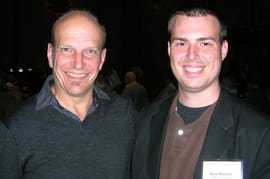Ancient Crocodile Helps Drexel Alum Land Dream Job

For Drexel alumnus Evan Boucher, life is good. With his master’s degree under his belt, awarded this past June, he just landed his dream job as a designer at DreamWorks. He’ll be the first to admit that a 65-million-year-old crocodile had a little something to do with it.
Boucher entered Drexel’s BS/MS program in Digital Media in 2005. He focused his master’s thesis on the digital reconstruction and animation of Thoracosaurus neocesariensis, an extinct genus of giant crocodile from the Late Cretaceous era. He worked with fossils discovered by Drexel’s Dr. Ken Lacovara and his team in New Jersey in late 2004.
The fossils included “most of the spinal cord, a partial femur and partial humerus,” Boucher says, “and pieces of the brain case, some teeth and a few pieces of the armored plates on the back.”
Boucher took several paleontology courses at Drexel and spent countless hours researching at the Academy of Natural Sciences of Drexel University to mentally flesh out the anatomy of this creature and learn its behavior and movement.
“I spent a lot of time in the Academy’s lab learning about this stuff. And there were entire weeks where I was doing nothing but reading papers on crocodiles,” he says. “There is definitely a lot of science involved.”
From there, he used his Drexel education and expertise in digital media to bring this ancient croc back to life on a computer screen. Boucher created a five-minute animation that shows a digital reconstruction of Thoracosaurus neocesariensis, starting with the skeleton, then the musculature and finally its flesh, coloring and outward appearance. It also reveals Boucher’s take on how the animal hunts and moves on land and in water. (View it here).
[iframe src="http://player.vimeo.com/video/14750657?title=0&byline=0&portrait=0" width="549" height="309" frameborder="0" webkitAllowFullScreen allowFullScreen]The animation earned Boucher the John J. Lanzendorf Prize for the National Geographic Digital Modeling and Animation Award from the Society of Vertebrate Paleontology, which he happily accepted in Las Vegas earlier this month. By his side was Lacovara, who served as a mentor to Boucher for this project.
“In paleontology, this award is a really big deal,” Boucher says. “It’s the top honor you can get for paleo-art.”
Just a few days later and still reeling from receiving the award, Boucher got the call from DreamWorks. He had interviewed with the company back in February, but didn’t land the job the first time, he says. When another position opened up a few weeks ago, however, a more-experienced Boucher interviewed with the company again and he used the crocodile animation to showcase his skills. It was a success and they offered him a job.
“I was ecstatic,” he says, “I felt like I was on top of the world.”
“I was ecstatic,” he says, “I felt like I was on top of the world.”
On November 28, Boucher will start as a character technical director at DreamWorks’ Redwood City office in California’s San Francisco Bay Area.
“Basically, I’ll be putting in a character’s controls, meaning adding the skeletons and muscles, so the animators can animate it,” he explains.
“Evan’s work transcends the boundaries between science, art, and technology,” says Lacovara. “He really stands as an example of what we hope to achieve with the Academy of Natural Sciences affiliation. The world needs more Evans and I’ll be watching his career with great pride.”
Drexel News is produced by
University Marketing and Communications.
